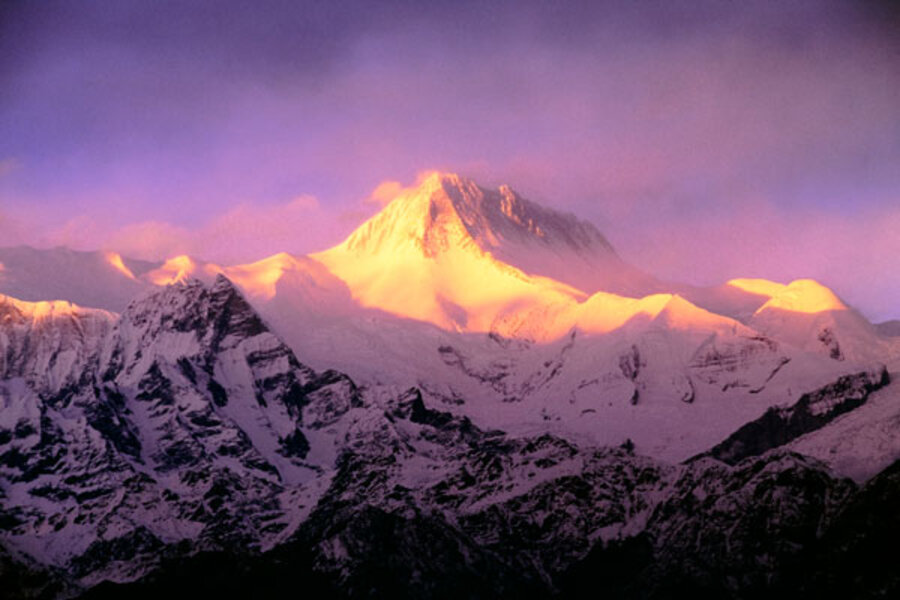What's really causing Himalayan glaciers to melt?
Loading...
Two weeks ago, it emerged that the UN's Intergovernmental Panel on Climate Change had made a mistake. The IPCC's last report, completed in 2007, had forecast that, given the current rate of global warming, Himalayan glaciers would "very likely" disappear by 2035.
This date, it turns out, wasn't based on a study appearing in a peer-reviewed science journal, but on an article published in the popular science magazine New Scientist a decade ago. The article apparently misquoted Indian glaciologist Syed Iqbal Hasnain.
Hasnain has said that he noted the error when it first appeared in print all those years ago, but never contacted the magazine about correcting it. How an article in the popular press made it into the pool of studies considered by the IPCC — the panel says it focuses on peer-reviewed studies — remains something of a mystery.
But, it should be noted, the erroneous estimate did not make it into the guide for policymakers. It appears only in the full report. So what about those glaciers?
Although there's still disagreement on how much Himalayan glaciers, sometimes called "the third polar region," are melting (see Monitor colleague Ben Arnoldy's story on the difficulties of studying ice in the volatile region) glaciologists tend to agree that they are melting, and that this poses a significant problem in the long run.
More than a billion people in Asia rely on glacial meltwater for a steady, year-round supply of fresh water. If the glaciers disappear, the region's water supply might be threatened.
Now, a new study by scientists at the Lawrence Berkeley National Laboratory, NASA's Goddard Institute for Space Studies, and NCAR, finds that human-emitted aerosols are the single major contributor to glacial melt in the Himalayas.
In this case, increasing concentrations of carbon dioxide are not melting the mountain glaciers, say the authors. Particulate matter, particularly black carbon from cooking fires and coal-fired plants in India, is the real culprit.
These particulates can melt ice in two ways. First, floating in the air, they absorb sunlight and heat the surrounding atmosphere. Warmer air melts glaciers and changes precipitation patters.
In fact, weather stations across India measured a decrease in sunlight reaching the ground of about 0.5 watts per square meter per year between 1964 to 1990. After 1990, that rate of decrease went up to 1.1 watts per square meter per year.
Particulates can also melt the ice when they precipitate out of the air and land on it. Snow and ice normally reflects much of the sun's energy — up to 90 percent — back the way it came. But a layer of soot on top of the ice will absorb the sunlight, warm the ice beneath, and melt it.
The current study, which appears in the journal Atmospheric Chemistry and Physics, finds that 90 percent of observed Himalayan glacial loss in recent decades is from aerosols. Black carbon soot alone, which occurs when combustion is incomplete, is responsible for 30 percent of that melt.
The amount of soot in the air has increased substantially in the area.
Between 1990 and 2000, black carbon emissions from India increased by 46 percent, say the authors. They increased by another 51 percent in the past decade.
According the National Snow and Ice Data Center, while some parts of the Himalayas have actually seen an increase in snow in recent decades, a large swath of the Himalayas has seen a decrease of about 16 percent in the same period.
The authors propose that the increases in snow in some regions is also an effect of black carbon — specifically, it heats the atmosphere, increases upward movement, or convection, of air, and that alters precipitation patterns. Rain and snow decrease in some areas and increase in others.
The good news is, while CO2 stays in the atmosphere for a century, black carbon lingers for a much shorter time. So if most of the Himalayan glacial melt observed in recent decades is due to not to increases in carbon dioxide but to more particulate pollution, then it can be much more easily addressed, at least theoretically: Simply burn coal and biomass more cleanly.
How difficult this may be to achieve is, of course, another story.
Editor's Note: The Monitor's Environment section has a new URL. And there's also a new URL for our Bright Green blog. We hope you'll bookmark these and visit often.





